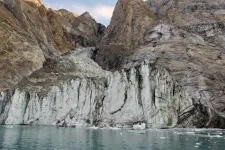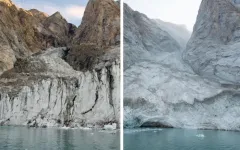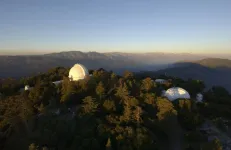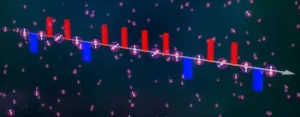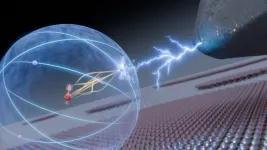(Press-News.org) In 2023, a massive rockslide in East Greenland, driven by glacial melt, triggered a towering tsunami and a rare global seismic signal that resonated for nine days, according to a new study. The study provides insights into how climate change-induced events like glacial thinning can lead to significant geophysical phenomena with impacts extending throughout the Earth system. Due to climate change, steep slopes are increasingly vulnerable to landslides. In Arctic regions – which are undergoing the most rapid warming globally – landslides can be driven by glacial debuttressing, permafrost degradation, and altered precipitation patterns. These landslides can trigger large and destructive tsunamis, particularly when they occur in confined water bodies like fjords. Such events have been recorded around the globe, including recently in West Greenland. Large tsunamigenic landslides produce long-period seismic waves, which can be detected remotely, and their tsunamis may create standing waves known as seiches, in which water sloshes back and forth at a specific resonant frequency. Seiches create long-period, monochromatic signals useful for studying energy transfer between the hydrosphere and the solid Earth. However, current observations of seiches have been limited to short-duration effects recorded by local seismometers. What’s more, numerical modeling of tsunami-induced seiches is limited, leaving a gap in understanding of how climate change can cause cascading, hazardous feedbacks between the cryosphere, hydrosphere, and lithosphere. Here, Kristian Svnnevig and colleagues report data from a significant landslide event in East Greenland that occurred in September 2023, which produced a very-long-period seismic signal that was detected globally for nine days. The event, which was triggered by glacial thinning, led to a massive rock-ice avalanche into Dickson Fjord, generating a 200-meter-high tsunami. This tsunami stabilized into a 7-meter-high long-duration seiche with a 90-second period, which produced a 10.88 millihertz (mHz) global seismic signal that resonated for nine days. Using a variety of geophysical techniques, Svennevig et al. show that the observed seismic signal was driven by the seiche. The findings further reveal that seiches in narrow fjords can produce long-duration seismic signals without persistent external driving forces, like strong winds or storm events.
END
Greenland landslide-induced tsunami produced global seismic signal that lasted 9 days
2024-09-12
ELSE PRESS RELEASES FROM THIS DATE:
Climate change-triggered landslide unleashes a 650-foot mega-tsunami
2024-09-12
In September 2023, scientists around the world detected a mysterious seismic signal that lasted for nine straight days. An international team of scientists, including seismologists Alice Gabriel and Carl Ebeling of UC San Diego’s Scripps Institution of Oceanography came together to solve the mystery.
A new study published today in Science provides the stunning solution: In an East Greenland fjord, a mountaintop collapsed into the sea and triggered a mega-tsunami about 200 meters (650 feet) tall. The giant ...
New study reveals food waste bans ineffective in reducing landfill waste, except in Massachusetts
2024-09-12
Of the first five U.S. states to implement food waste bans, only Massachusetts was successful at diverting waste away from landfills and incinerators, according to a new study from the University of California Rady School of Management.
The paper, published today in Science, suggests a need to reevaluate current strategies, citing Massachusetts' approach as a benchmark for effective policy implementation.
Between 2014 and 2024, nine U.S. states made it unlawful for commercial waste generators—such as grocery chains—to dispose of their food waste in landfills, expecting a 10–15% waste reduction.
“We ...
New research reveals how El Nino caused the greatest ever mass extinction
2024-09-12
Mega ocean warming El Niño events were key in driving the largest extinction of life on planet Earth some 252 million years ago, according to new research.
The study, published today in Science and co-led by the University of Bristol and China University of Geosciences (Wuhan), has shed new light on why the effects of rapid climate change in the Permian-Triassic warming were so devastating for all forms of life in the sea and on land.
Scientists have long linked this mass extinction to vast volcanic eruptions in what is now Siberia. The resulting carbon dioxide emissions rapidly accelerated climate warming, resulting in widespread stagnation and the collapse ...
Climate-change-triggered landslide caused Earth to vibrate for nine days
2024-09-12
A landslide in a remote part of Greenland caused a mega-tsunami that sloshed back and forth across a fjord for nine days, generating vibrations throughout Earth, according to a new study involving UCL researchers.
The study, published in the journal Science, concluded that this movement of water was the cause of a mysterious, global seismic signal that lasted for nine days and puzzled seismologists in September 2023.
The initial event, not observed by human eye, was the collapse of a 1.2km-high mountain peak into the remote Dickson Fjord beneath, causing a backsplash of water 200 metres in the air, with a wave up to 110 metres high. This ...
Microbe dietary preferences influence the effectiveness of carbon sequestration in the deep ocean
2024-09-12
Woods Hole, Mass. (September 13, 2024) - The movement of carbon dioxide (CO2) from the surface of the ocean, where it is in active contact with the atmosphere, to the deep ocean, where it can be sequestered away for decades, centuries, or longer, depends on a number of seemingly small processes.
One of these key microscale processes is the dietary preferences of bacteria that feed on organic molecules called lipids, according to a journal article, "Microbial dietary preference and interactions affect the export of lipids to the deep ocean," published in Science.
"In ...
The insulator unraveled
2024-09-12
Aluminum oxide (Al2O3), also known as alumina, corundum, sapphire, or ruby, is one of the best insulators used in a wide range of applications: in electronic components, as a support material for catalysts, or as a chemically resistant ceramic, to name a few. Knowledge of the precise arrangement of the surface atoms is key to understanding how chemical reactions occur on this material, such as those in catalytic processes. Atoms inside the material follow a fixed arrangement, giving rise to the characteristic shapes ...
$3.5M grant to Georgia State will fuel space research across the globe
2024-09-12
ATLANTA — A new three-year, $3.5 million grant from the U.S. National Science Foundation will foster new research at Georgia State’s Center for High Angular Resolution Astronomy (CHARA) Array by astronomers from around the world.
The grant will fund open-access time at the CHARA Array through the NSF National Optical-Infrared Astronomy Research Laboratory (NSF NOIRLab). The program offers astronomers the opportunity to apply for observing time at the CHARA Array to investigate all kinds of objects ...
Polar molecules dance to the tunes of microwaves
2024-09-12
The interactions between quantum spins underlie some of the universe’s most interesting phenomena, such as superconductors and magnets. However, physicists have difficulty engineering controllable systems in the lab that replicate these interactions.
Now, in a recently published Nature paper, JILA and NIST Fellow and University of Colorado Boulder Physics Professor Jun Ye and his team, along with collaborators in Mikhail Lukin’s group at Harvard University, used periodic microwave pulses in a process known as Floquet engineering, to tune interactions between ultracold potassium-rubidium molecules in a system appropriate for studying fundamental magnetic ...
Quantum researchers cause controlled ‘wobble’ in the nucleus of a single atom
2024-09-12
Researchers from Delft University of Technology in The Netherlands have been able to initiate a controlled movement in the very heart of an atom. They caused the atomic nucleus to interact with one of the electrons in the outermost shells of the atom. This electron could be manipulated and read out through the needle of a scanning tunneling microscope. The research, published in Nature Communications today, offers prospects for storing quantum information inside the nucleus, where it is safe from external disturbances.
For weeks on end, the researchers studied a single titanium atom. “A Ti-47 atom, to be precise,” ...
Foods with low Nutri-Scores associated with an increased risk of cardiovascular diseases
2024-09-12
Cardiovascular diseases are the leading cause of mortality in Western Europe, accounting for 1/3 of deaths in 2019. Diet is thought to be responsible for around 30% of such deaths. Nutrition-related prevention policies therefore constitute a major public health challenge for these diseases.
In an article to be published on 11 September 2024 in Lancet Regional Health - Europe, researchers from the Nutritional Epidemiology Research Team (CRESS-EREN), with members from Inserm, Inrae, Cnam, Université Sorbonne Paris Nord and Université Paris ...
